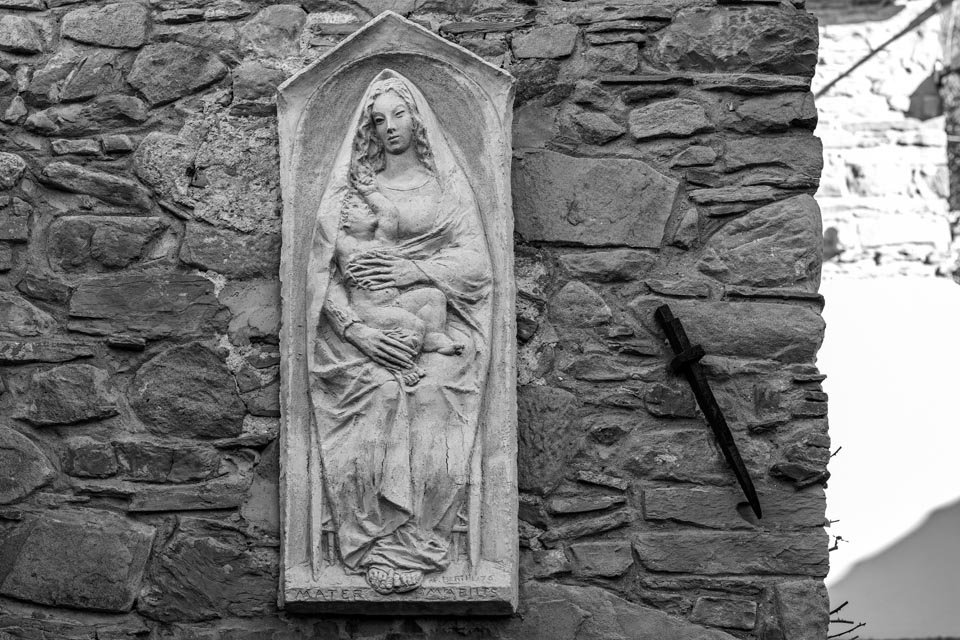Mater Amabilis – Antonio Berti
Borgo Museo | Sculture 1976 – 2004
ITALIANO | English below
La vita
Nato a San Piero a Sieve nel 1904, Antonio Berti è allievo di Libero Andreotti all’Istituto d’Arte di Firenze dal 1921 al 1929 ed esordisce come pittore alla Biennale di Venezia, ottenendo subito un discreto successo. Dal 1934 decide però di dedicarsi alla scultura. Esegue la statua di Ugo Foscolo, destinata al sepolcro del poeta in Santa Croce (1935). Gli anni che seguono sono ricchi di lavoro e l’apprezzamento dei critici gli procura fama: Berti diviene ritrattista ufficiale di personaggi come il conte Volpi, Barbara Hutton, esponenti di case reali. Tra il 1938 ed il 1939 l’artista lavora al Monumento a Garbarino, grande altorilievo in marmo raffigurante l’apoteosi del lavoro. In seguito realizza il monumento a S. Luisa di Marillac nella Basilica di San Pietro a Roma (1954), quello di Alcide De Gasperi a Trento (1956), la statua di Pio XII in Piazza San Lorenzo a Roma (1967) e l’altare maggiore della Cattedrale di Reggio Calabria (1965). Partecipa a numerose mostre in Italia e all’estero e dal 1959 al 1974 ha la cattedra di scultura presso l’Accademia di Belle Arti di Firenze, città dove trascorre buona parte della propria vita. Negli anni ‘70 e ‘80 esegue ancora molti ritratti e riceve commissioni impegnative, tra le quali quelle per il monumento a Padre Pio a San Giovanni Rotondo (1975) e per la parte bronzea della cattedrale di Castellammare di Stabia (1983). Espone inoltre a Parma, con Annigoni e Tessoni (1974) e all’Accademia delle Arti e del Disegno di Firenze (1975-76). L’ultima sua fatica risale al 1987, con il monumento a Giuseppe Mazzini a Firenze. Un’antologica a lui dedicata si è tenuta a San Piero a Sieve, suo paese natale, nel 1989, a cura di Raffaele De Grada, Tommaso Paloscia e Domenico Viggiano. Muore a Sesto Fiorentino nel 1990.
La poetica
Antonio Berti si avvicina all’arte come pittore ma presto s’innamora della scultura e si afferma come scultore. Gli insegnamenti di Andreotti hanno affinato il suo virtuosismo, che riporta senza dubbio a Canova, anche se Berti dichiara la propria ammirazione per Donatello, Jacopo della Quercia ed i romantici; evidenti sono anche i richiami al Verrocchio: le superfici levigate, la purezza formale, l’eleganza e la raffinatezza.
L’opera a Castagno
La collezione del Museo all’aperto di Castagno ospita diverse maternità, tra cui Mater Amabilis di Antonio Berti. La scultura, un altorilievo, raffigura una madre con in braccio il proprio figlio. La donna è rappresentata in posizione seduta, vestita con abiti leggeri che però non lasciano intravedere nessuna parte del suo corpo. Il bambino è ritratto in una situazione di totale tranquillità, protetto da tutto ciò che lo circonda attraverso l’abbraccio materno, mentre gioca con una ciocca di capelli della madre. Il viso di lei pare inespressivo mentre quello del bambino rivela quanto si senta rilassato e al sicuro. Le mani della donna sono sproporzionate rispetto al resto del corpo e il suo velo cade proprio sulla testa del piccolo, entrambi segni di protezione; altro particolare, i piedi che fuoriescono da sotto il lungo abito. In questa scultura, l’artista esprime una sintesi del rapporto unico e inconfondibile tra madre e figlio, fondato sul senso di assoluta protezione e assoluto amore.
ENGLISH
Biography
Born in San Piero a Sieve in 1904, Antonio Berti was a pupil of Libero Andreotti at the Art Institute of Florence from 1921 to 1929 and made his debut as a painter at the Venice Biennale, immediately achieving some success. However, from 1934 he decided to devote himself to sculpture. He creates the statue of Ugo Foscolo, destined for the poet's sepulchre in Santa Croce (1935). The following years were full of work and the appreciation of the critics earned him fame: Berti became the official portraitist of characters such as Count Volpi, Barbara Hutton, exponents of royal houses. Between 1938 and 1939 the artist worked on the Garbarino Monument, a large marble high relief depicting the apotheosis of work. Later he created the monument to St. Luisa di Marillac in St. Peter's Basilica in Rome (1954), that of Alcide De Gasperi in Trento (1956), the statue of Pius XII in Piazza San Lorenzo in Rome (1967) and the main altar of the Cathedral of Reggio Calabria (1965). He participates in numerous exhibitions in Italy and abroad and from 1959 to 1974 held the chair of sculpture at the Academy of Fine Arts in Florence, the city where he spends most of his life. In the 1970s and 1980s he still painted many portraits and received demanding commissions, including those for the monument to Padre Pio in San Giovanni Rotondo (1975) and for the bronze part of the cathedral of Castellammare di Stabia (1983). He also exhibits in Parma, with Annigoni and Tessoni (1974) and at the Academy of Arts and Design in Florence (1975-76). His last effort dates back to 1987, with the monument to Giuseppe Mazzini in Florence. An anthology dedicated to him was held in San Piero a Sieve, his birthplace, in 1989, curated by Raffaele De Grada, Tommaso Paloscia and Domenico Viggiano. He died in Sesto Fiorentino in 1990.
Philosophy
Antonio Berti approaches art as a painter but soon falls in love with sculpture and establishes himself as a sculptor. Andreotti's teachings have refined his virtuosity, which he undoubtedly brings back to Canova, even if Berti declares his admiration for Donatello, Jacopo della Quercia and the romantics; The references to Verrocchio are also evident: smooth surfaces, formal purity, elegance and refinement.
Artwork in Castagno
The collection of the Castagno Open Air Museum houses various maternity wards, including Antonio Berti's Mater Amabilis. The sculpture, a high relief, depicts a mother holding her child in her arms. The woman is represented in a seated position, dressed in light clothing which, however, does not reveal any part of her body. The child is portrayed in a situation of total tranquility, protected from everything around him through the mother's embrace, while he plays with a lock of his mother's hair. Her face looks expressionless while the baby's reveals how relaxed and safe he feels. The woman's hands are disproportionate to the rest of her body and her veil falls right on the baby's head, both signs of protection; another detail, the feet that protrude from under her long dress. In this sculpture, the artist expresses a synthesis of the unique and unmistakable relationship between mother and child, based on the sense of absolute protection and absolute love.

